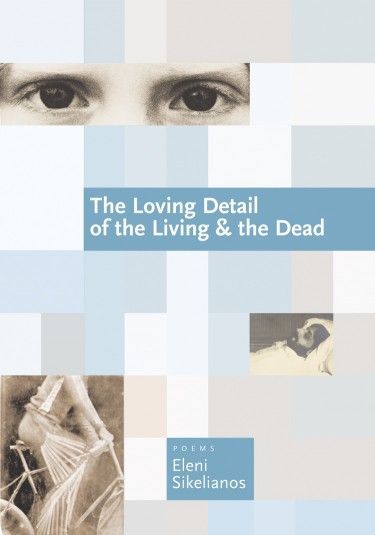to pan esti somata kai kenon.
—Epicurus
In the beginning there were “meat subjects” and birds, and words “like a boat that begins to take water /before the storm”—atoms that are able to is, so therefore also able to not— woven into a space containing shifting time-governed bodies. It is through these bodies and their shadows that Eleni Sikilianos’s The Loving Detail of the Living & the Dead guides us. An autogeography of time, the shifting frame through which matter becomes itself, these poems reflect on containment: What does it mean to be a body? What does it mean to escape it?
In The Loving Detail of the Living & the Dead, we wind our way through the Upper Paleolithic where we are all things, have been all things, and destroy all things. We move, perhaps because of our inalienable desire to colonize, infinitely through space attempting to erase the places that preexisted us; we replace: “[s]oon so many persons made so many person-things/till it seemed all that was left of the world was human.” This deliberate personing applies to inner-space as well: “[I had a dream of keeping the body inside the skull [private territory], shadowless].” And, while we person the space around us, the insides of us have been personed as well: “what my mother learned is in my mind/like a sheet of glass”.
Is the one place we cannot fully occupy inside us?
The Mitochondrial DNA in human cells travels unhampered through time, from hundreds of thousands of years ago to this very moment inside our living bodies, it is a record of our cellular ancestry from the first mother—our mitochondrial Eve. In this way we are at once ourselves and another, ourselves and each other. We have been personed from the inside since before we existed. The
mitochondrial Eve of the book shows up as Charlene. Charlene is “a goddess,” “a living woman,” our “mon semblable,” an infinite being, who both was and is, appearing in several poems, simultaneously situating and displacing us amongst the living and the dead, only to ultimately place us, halfway through the book, inside a megaphone:
There are actually two heavens
& one’s called Hell & one’
called Heaven
& they speak to each other
through a megaphone
& in one we make ideas
& the other we destroy them
I make an idea in Heaven
Hell destroys it
I make an idea in Hell
Guess what Heaven does
If the megaphone stands as the place between the two Heavens then we live inside the megaphone. The ideas of everything pass through us, only to be destroyed almost as soon as they are uttered, leaving us in a sort of ever-was and ever-becoming reality.
As our guide, Charlene explains Nature, God, our “muddy bodies”, landscape and color…. She knows where we came from and where we are going to in this multidimensional world of living ghosts through which we are eternally moving with dis/ease. Everything is shadowed—everything both is and is not its opposite. To walk through grass is to walk through the shadow of grass, just as to hold space is to make a place out of it. Wherever the eye falls, the I defines. Knowing this, Sikelianos carries us through some of the darker moments of being human with generosity, exquisite tenderness, and humor. The Loving Detail of the Living & the Dead is a stunning sketch on what it means to be human and carry our humanity around inside ourselves through the ages. It embraces the eternal moment, “picks up its shadow like a baby and carries [us] home.”
